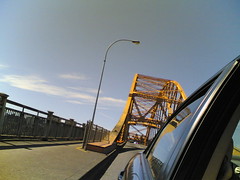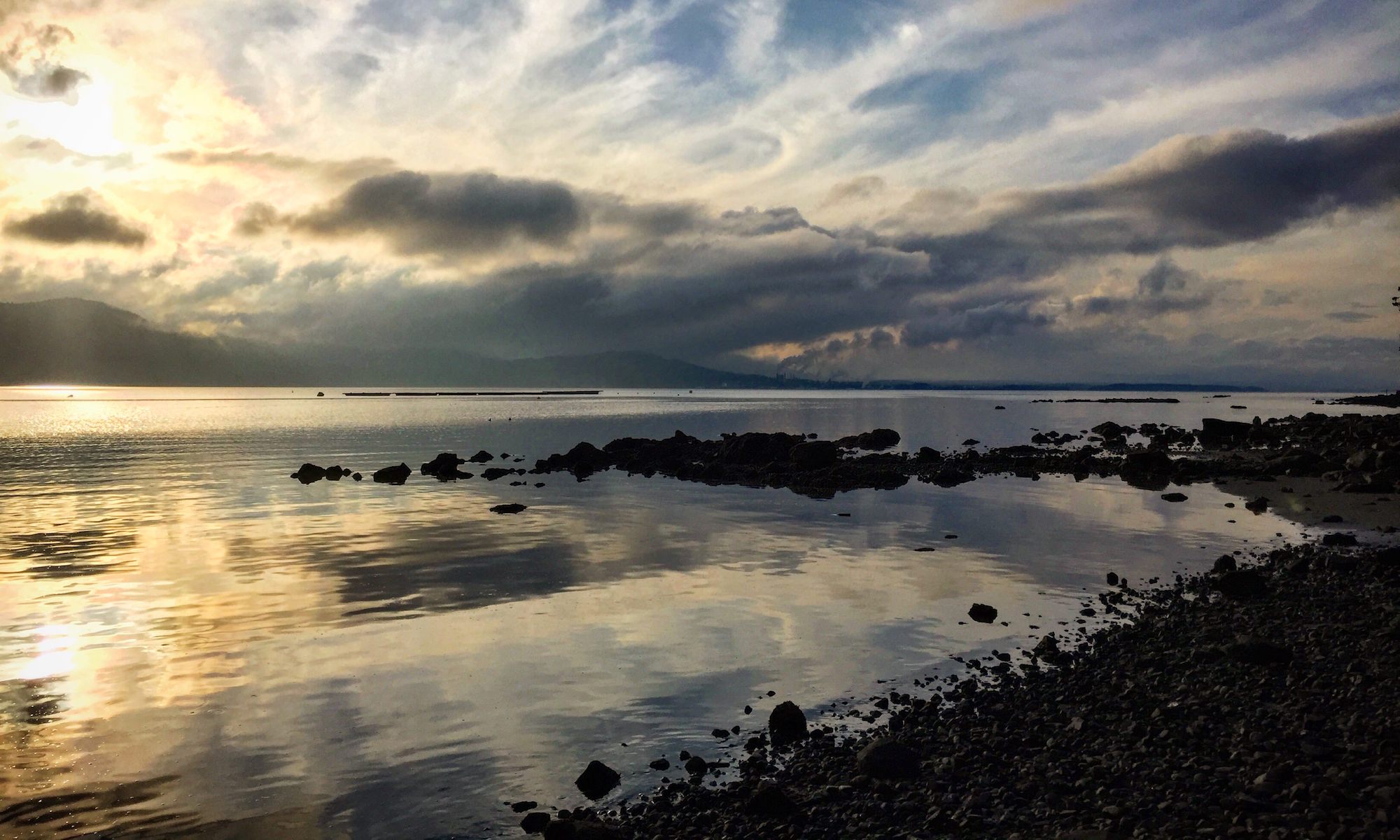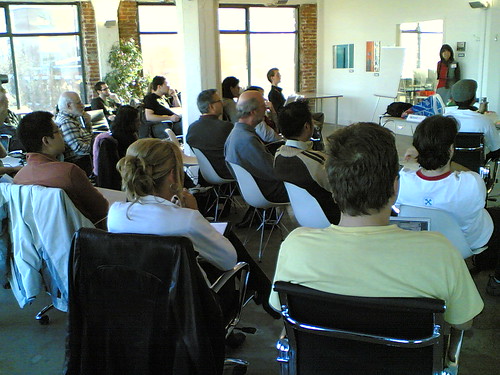There are a lot of great things being discussed and talked about here at Vancouver TransitCamp. I know this only because I’m over hearing some of the conversation. There’s so much being talked about that it makes me have a lot of various thoughts about the mass transit system that exists in and around Vancouver, the “Metro Vancouver” area for those not hip to the lingo(because it’s no longer, officially, known as the GVRD), I thought I’d hit a few topics that stick out to my mind.
First, the Gateway Project. Long story short, they want to twin the Port Mann bridge and allow a higher volume of automobile traffic flow through that area. I don’t like the plan, and there were people here this morning, SPEC, who are doing everything they can to help stop it.
Gateway is a real waste of money and the wrong thing to do environmentally. More care should be given to resist the notion of where more lanes of road will lead to less traffic congestion. Instead, the money going into that project should be given to massively expand SkyTrain service through Surrey and Langley. That expansion should loop around and come back across at the Port Mann bridge. That would help to reduce the amount of commuters coming across the bridge, from the east, if they had an accessible, reliable method like the SkyTrain.
And the SkyTrain… It needs continued expansion, and I really hesitate to say that. However, the reality is the necessity that a growing city like Vancouver needs something to handle the amount of people that are arriving in the lower mainland every day, week, and month. Could you imagine what it would be like if you could not only train from YVR but the ferry ports or even North Vancouver? Madness would precede it before it happened, but imagine what it would be like after.
The bus system… more should be done to increase its reliability. GPS tracking on the buses would certainly influence this, no matter how big brother it sounds. With my recent pains of commuting through the Canada Line construction, I would love to know if I have to wait five minutes or a half hour for the next bus to arrive. I’m not afraid of walking. What I’m afraid of is being a block away when the bus comes and makes me committed to walking the rest of the way, ending up being late for work.
I might add to this post or make more posts about other topics, but these are the issues at the top of my head.
Post edit: Dec. 9, 2007
It’s been a few days since this post that I’m making this edit, and I just wanted to add on here what Ryan and Keith said in the comments below. I applaud them for helping me understand the issue better, and it’s probably something that I needed reminding of rather than not acknowledging.
There certainly is a problem with the flow of traffic coming into Vancouver and across the Port Mann[wiki] bridge. I think it’s safe to say that there is no way that adding more car lanes will solve everything as much as saying that by adding more bus or rail transit will be the ultimate solution. However, I do like the combination of both, and that makes a lot more sense to me. Still, there needs to be a massive upgrade/expansion of service of rail transit for Surrey and Langley if the project would to really solve the problem, and I just don’t see the bureaucratic powers that be making that happen.
 In the original post, I forgot entirely, as most people do, about the Pattullo Bridge[wiki]. It’s not another, simple or easy solution to the problem, but what would an overhaul of that bridge do for traffic around the lower mainland? The bridge is in desperate need of being replaced because repairs will not cut it on a bridge that is outdated in many aspects.
In the original post, I forgot entirely, as most people do, about the Pattullo Bridge[wiki]. It’s not another, simple or easy solution to the problem, but what would an overhaul of that bridge do for traffic around the lower mainland? The bridge is in desperate need of being replaced because repairs will not cut it on a bridge that is outdated in many aspects.
If the bridge were to be widened and better planning was done to the traffic patterns to and from the bridge, could that help the congestion of the Port Mann as well? Combine that with twinning and SkyTrain expansion, and you might see more people taking the Pattullo rather than the Port Mann. I shouldn’t fail to mention the Golden Ears Bridge[wiki] project that might aid in less congestion at the Port Mann once it is completed. Once again, not the answer, but a potential release valve for Highway 1.
Still, I don’t like the idea of where more means less problems, especially in an area that is a major traffic problem on each side of the bridge. I used to drive around that area on a consistent basis with large, diesel fueled, broadcast vehicles. The notion of getting it wrong, or whatever is done to help the problem, is what should concern more people about this project.



Most of the time I agree with your take on things, it’s generally pretty balanced and logical. But I have to say that you’re off the mark about the twinning of the Port Mann. Trying to commute from Fraser Heights to my office in Burnaby would take about an hour each way, with half of that time spent waiting in line for the bridge. Right now, transit just isn’t a viable option.
Do we need more SkyTrain? ABSOLUTELY! They should run two lines out to the valley, one up the #1, and another up Fraser Highway. Not to mention the planned Evergreen line up the North-side of the Fraser.
Bottom line: When my wife and I bought our new place, we had to move OUT of Surrey and into the ever-more-crowded city of Burnaby (we looked at Vancouver too).
We have cars. Lots of cars, there are more than ever before and we have to deal with that. We’re getting better, more fuel-efficient cars, hybrids, carpooling etc. etc. People love their cars, and as we move forward and even more energy-efficient and environmentally-friendly technologies come to the fore, we’ll have more and more cars they just won’t hurt the environment as much.
There’s no one solution to transit and transportation. If you get enough people going to one place, then you’ll be able to use mass transit options. For the next 20 years, most of Surrey, Langley, Aldergrove, Abbotsford and others will still be relatively low-density areas. Rapid transit, and even buses in many cases won’t be financially viable options. Cars will be critical and we’ll have to build the infrastructure to deal with them.
There are backups, lineups for the Port-Mann bridge Seven Days a Week right now, and it’s purely due to volume. I go back to Surrey on the weekends to visit friends and family and without exception there are lineups for the bridge (and only the bridge) at mid-day every weekend!
So let’s twin the bridge, but let’s also run SkyTrain down that bridge and truly provide an option for people from outside Vancouver, Burnaby and Richmond can have some really usable transit options.
As attractive as the idea of not adding car capacity to the #1 is, it won’t work. The issue isn’t getting people to the other side of the Port Mann (which yes, Skytrain would do nicely), it’s getting people to the vast and growing low-density areas beyond Surrey, which is pretty much everything from Langley to Hope.
Yes, those are long distance trips made by large numbers of people and goods. There is no especially practical public transit solution for handling these volumes of traffic bottlenecked through four lanes at one crossing before dispersing to an area several times the size of Metro Vancouver.
So Skytrain over that corridor would greatly benefit the thousands of people who live near 152nd and 108th in Surrey, and do almost nothing for the hundreds of thousands beyond them.
Keith and Ryan, you both made some good points. Read my post edit above to get some more response.
Twinning the Port Mann bridge might reduce congestion because it means removing a bottleneck – more lanes lead to the bridge than cross it. Unfortunately that is not what is being proposed. The province wants to widen the freeway on both sides as well. All that does is build a bigger bottleneck.
All experience with freeway expansion has been shown to be fruitless in terms of dealing with congestion (see for examples http://mobility.tamu.edu/ums/)
The province has also decided – against all the evidence – not to use a tolling strategy to control congestion but rather to stay in line with the outdated notion that tolls simply pay for the new infrastructure – but now with the addition of – and make profits for a private sector partner.
For much more information I suggest you visit the Liveable Region Coaltion’s web site and read the submissions we made to the Environmental Assessment Process